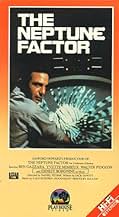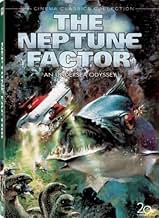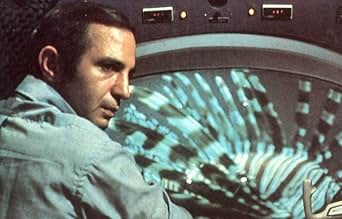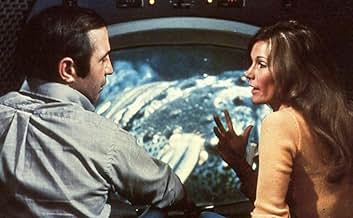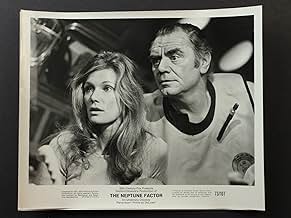IMDb-BEWERTUNG
4,4/10
1429
IHRE BEWERTUNG
Füge eine Handlung in deiner Sprache hinzuWhen an underwater ocean lab is lost in a earthquake, an advanced submarine is sent down to find it and encounters terrible danger.When an underwater ocean lab is lost in a earthquake, an advanced submarine is sent down to find it and encounters terrible danger.When an underwater ocean lab is lost in a earthquake, an advanced submarine is sent down to find it and encounters terrible danger.
- Auszeichnungen
- 1 Nominierung insgesamt
Ken Pogue
- Diver Thomas
- (as Kenneth Pogue)
Empfohlene Bewertungen
5JHC3
Oceanlab is an experimental station built atop an undersea mountain in the
North Atlantic somewhere off the coast of Canada. An earthquake strikes,
causing the lab to plunge into an unexplored abyss. Three men are trapped
aboard and they have only seven days of oxygen remaining.
After five days, the Oceanlab team is able to call in a retired naval officer, Commander Blake (Gazzara). Using his deep sea submersible "Neptune II," it
is hoped he can locate and rescue the men before they suffocate. The hope is a slim one; all contact with the lab was lost when the earthquake occurred. The submersible must face the hazards of deep sea travel, aftershocks, and some
very unexpected discoveries on the ocean floor.
The cast is unusually strong with Ernest Borgnine, Donnelly Rhodes, Yvette
Mimieux, and Walter Pigeon all putting in good performances. The special
effects are limited to model work for undersea shots, but the models are decent enough given the year of release. The film starts out well with the opening
score being particularly noteworthy. Unfortunately, once the submersible gets in the water, the viewer is taken for a rather dull ride for the bulk of the film. Suspense is largely absent. In lieu of pacing, the filmmakers subject the viewer to a lot of stock fish footage. While this was decent enough, it was overused and probably better suited to a nature documentary. Ultimately, the screenplay
needed some serious work. There is insufficient substance to make this work
even as a one hour Twilight Zone or Outer Limits episode. "The Neptune
Factor" otherwise possessed all of the elements necessary to make a successful and compelling adventure film.
North Atlantic somewhere off the coast of Canada. An earthquake strikes,
causing the lab to plunge into an unexplored abyss. Three men are trapped
aboard and they have only seven days of oxygen remaining.
After five days, the Oceanlab team is able to call in a retired naval officer, Commander Blake (Gazzara). Using his deep sea submersible "Neptune II," it
is hoped he can locate and rescue the men before they suffocate. The hope is a slim one; all contact with the lab was lost when the earthquake occurred. The submersible must face the hazards of deep sea travel, aftershocks, and some
very unexpected discoveries on the ocean floor.
The cast is unusually strong with Ernest Borgnine, Donnelly Rhodes, Yvette
Mimieux, and Walter Pigeon all putting in good performances. The special
effects are limited to model work for undersea shots, but the models are decent enough given the year of release. The film starts out well with the opening
score being particularly noteworthy. Unfortunately, once the submersible gets in the water, the viewer is taken for a rather dull ride for the bulk of the film. Suspense is largely absent. In lieu of pacing, the filmmakers subject the viewer to a lot of stock fish footage. While this was decent enough, it was overused and probably better suited to a nature documentary. Ultimately, the screenplay
needed some serious work. There is insufficient substance to make this work
even as a one hour Twilight Zone or Outer Limits episode. "The Neptune
Factor" otherwise possessed all of the elements necessary to make a successful and compelling adventure film.
The Neptune Factor deals with some scientists who live and work out of an undersea lab in the Atlantic Ocean. One fine day while their bosses, Walter Pidgeon, Yvette Mimieux, and Ernest Borgnine are up top, an earthquake occurs and the lab topples over into an underwater crevice.
Though an atomic power submarine could stay down there indefinitely the problem is that crevice is way too small for one of those big boys. A smaller type submarine able to withstand the pressures of the very deep is needed and that's where Ben Gazzara and his ship the Neptune come in.
As disaster films go The Neptune Factor is small potatoes special effects wise. It's a Canadian production and I've seen Hollywood come up with worse films spending a ton more money than was done here.
The special effects such as they are, are merely movie films of some ordinary species of marine life blown up several times their size, because these are the creatures the crew finds down at depths that man hasn't been before. It's beautiful undersea photography just like a trip to Marineland.
It's a no frills production, no subplots of any kind, no social interaction of any kind with the crew, just do the mission and go home. That's why it was given a G rating when first released.
If you love Jacques Cousteau, you'll love this film.
Though an atomic power submarine could stay down there indefinitely the problem is that crevice is way too small for one of those big boys. A smaller type submarine able to withstand the pressures of the very deep is needed and that's where Ben Gazzara and his ship the Neptune come in.
As disaster films go The Neptune Factor is small potatoes special effects wise. It's a Canadian production and I've seen Hollywood come up with worse films spending a ton more money than was done here.
The special effects such as they are, are merely movie films of some ordinary species of marine life blown up several times their size, because these are the creatures the crew finds down at depths that man hasn't been before. It's beautiful undersea photography just like a trip to Marineland.
It's a no frills production, no subplots of any kind, no social interaction of any kind with the crew, just do the mission and go home. That's why it was given a G rating when first released.
If you love Jacques Cousteau, you'll love this film.
Not a bad effort, really, given that the film was made during the age of Cousteau. Underwater filming of deep ocean life had not been accomplished. Now we know what it looks like way down there, so the fish tank 'special effects' really ruin the story. The first sight of a clown fish is like a slap in the face! The film becomes a comedy after that! But really, this is only because science education (as miserable as it may be) has advanced SO MUCH on television. Now we can sit on our sofa and watch animal planet to get a better seminar on deep ocean life than marine biologists of the day received! So, if you're looking for a top-notch special effects masterpiece, the toy sub floating in the Monterey Bay aquarium's fish tanks probably won't cut it. Nevertheless, it's an entertaining few minutes, anyway. I say, watch it and try to forget about reality for a while. Pretend you're TEN!
This waterlogged bore is about 100 minutes but feels about 120 minutes too long. A film so dull even the cast can't rouse itself from lethargy. Yvette Mimieux evidently decided her paycheck was only enough to guarantee that she'd show up, because her performance consists of only one half-lost/blank stare throughout. Borgnine, once again in the water (McHale, Poseidon, etc.) can barely rouse himself to his usual level of histrionics. Gazzara tries a southern accent and fails, while Walter Pigeon plods through his role, obviously taking his check to pad his retirement fund (he actually turned in a fine performance the following year in 'Harry in Your Pocket'). This is a Canadian film, thus it's restricted budget-wise, but why bother making a film like this if you haven't got the money for the special effects? We're talking $1.98 here. It looks like the producers bought a little toy submersible and borrowed someone's aquarium and let er rip. Okay, this is pre-Star Wars, effects-wise, but no one could take this seriously even back in 1973. Oh the look of fear and awe on Borgnine's face when he sees a.... giant goldfish! Perhaps the only thing of (minor) interest is whether James Cameron was inspired by this film to create 'The Abyss.' It does have some of the same elements. Of course, unlike 'The Abyss', this film is idiotic (example: Gazzara yelling at Mimieux for putting the sub in danger of exploding from sea pressure, yet the same pressure has no effect on HUMAN BODIES swimming around in EVEN GREATER DEPTHS soon after), and it's dully plotted, acted, directed, written, scored. Well, it IS consistent!
For a movie about a race against the clock to rescue a group of scientists trapped in an undersea research facility that's been hit by an earthquake, The Neptune Factor is incredibly dull. The problem is that for most of the movie, nothing happens. Ernest Borgnine (who I'll give a little credit as he does his best with this snoozer of a script), Ben Gazzara, and company spend most of the movie on a slow motion tour of the ocean floor looking for their missing colleagues. Garzzara is the worst, showing the same kind of emotion usually reserved for everyday, mundane tasks like doing the laundry or grocery shopping. You'd hardly know from his demeanor that the lives of three people rest in his hands. And when something does finally happen the special effects are so ridiculous looking that the movie losses any credibility it might have had. The "giant" sea creatures the rescuers run into are little more than normal salt water aquarium fish filmed with a zoom lens and a bad looking miniature of the submarine. That's right - The Neptune Factor looks like it was filmed in someone's home aquarium. A giant clown fish - oooooh, how scary! There's nothing much more frightening than the sight of a ludicrously large Nemo.
To say I was disappointed by The Neptune Factor would be a gross understatement. A good cast is put to waste with nothing to do. In the end, I've got to rate this one a 2/10.
To say I was disappointed by The Neptune Factor would be a gross understatement. A good cast is put to waste with nothing to do. In the end, I've got to rate this one a 2/10.
Wusstest du schon
- WissenswertesProducer Sandy Howard consulted a large number of marine biologists, oceanographers, and ichthyologists two years prior to taking the script into production.
- PatzerNeptune's crew was able to watch through the submarine's glass window all the objects and fish around them under sunlight although they were deeper than 300 meters from the sea surface. Sunlight is barely seen in the sea bottom at depths greater than 200m.
- Zitate
Dr. Leah Jansen: And those jawfish! The ones I've seen have been only two inches long. Look at them!
- VerbindungenReferenced in Die schwarze Windmühle (1974)
Top-Auswahl
Melde dich zum Bewerten an und greife auf die Watchlist für personalisierte Empfehlungen zu.
Details
- Erscheinungsdatum
- Herkunftsländer
- Sprache
- Auch bekannt als
- The Neptune Disaster
- Drehorte
- Produktionsfirmen
- Weitere beteiligte Unternehmen bei IMDbPro anzeigen
Box Office
- Budget
- 2.500.000 CA$ (geschätzt)
Zu dieser Seite beitragen
Bearbeitung vorschlagen oder fehlenden Inhalt hinzufügen


